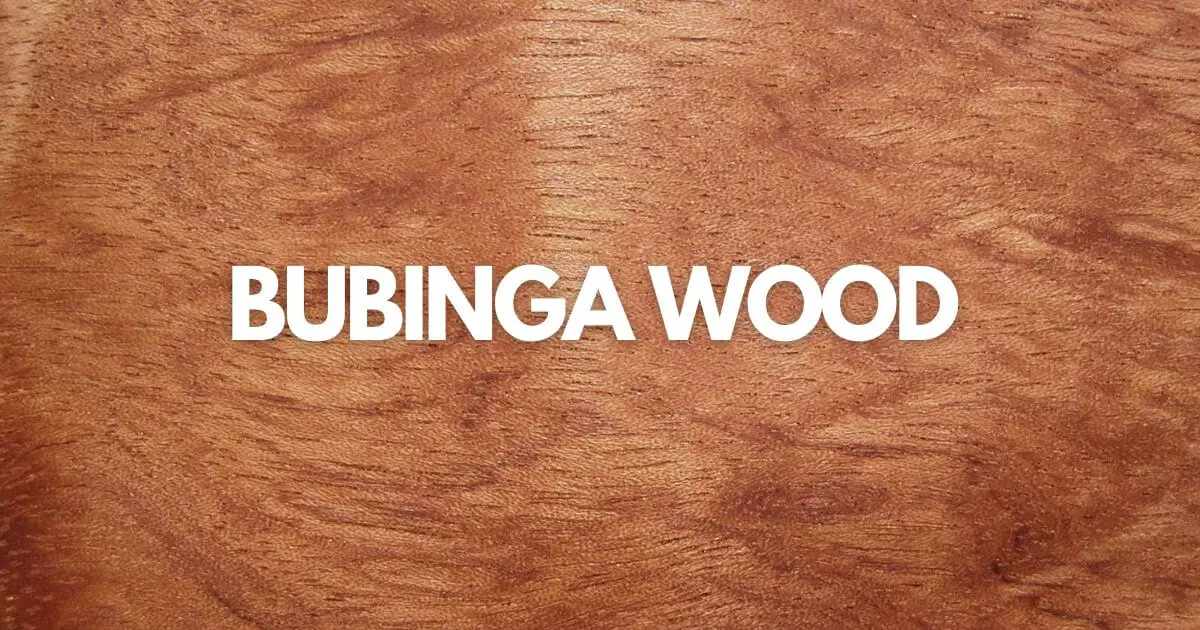What is Bubinga Wood?
Bubinga Wood is also known as African Rosewood, which is native to tropical regions of Africa. It has excellent strength, durability, and rot resistance ability, making it a good choice for furniture.
There are 16 more species of Guibortia, of which 13 are native to Africa. It is a large hardwood tree species with a cylindrical trunk and a broad, spreading crown of foliage.
| # | Bubinga |
| Scientific name | Guibourtia spp. |
| Tree Size | 100-150 ft (31-45 m) tall, 2-6 ft (0.6-2 m) trunk diameter |
| Janka Hardness | 2,410 lbf (10,720 N) |
| Average Dried Weight | 56 lbs/ft3 (890 kg/m3) |
| Modulus of Rupture | 24,410 lbf/in2 (168.3 MPa) |
| Crushing Strength | 10,990 lbf/in2 (75.8 MPa) |
| Type | Hardwood |
Uses
Bubinga wood is a popular choice for a variety of applications. It is an excellent choice for high-end furniture, veneer, cabinetry, flooring, turning, and decorative objects.
It is also famous for musical instruments due to its excellent resonance properties, making it well-suited to produce a rich, warm, and full sound. It is used for making guitars, drums, xylophones, and woodwinds.
Appearance
The heartwood ranges from pinkish-red to reddish-brown, with dark purple or black streaks running through the wood, while the sapwood is pale color. The grain patterns in Bubinga wood can be straight or interlocked with uniform fine to medium texture and moderate natural luster.
Workability
Bubinga wood is easy to work with machine and hand tools but can be difficult due to its high density and heavyweight. But using the right tools can help.
Bubinga has interlock and irregular grain patterns that tear out during planing. It contains silica which can be challenging for final finishing, and can also blunt tools.
Rot-resistant
Whenever we are about to use any wood for outdoor or ground contact purposes, the first question that comes to our mind is whether that wood is rot-resistant or not.
Bubinga has excellent resistance to rot, termite, and marine borer attack. Therefore it is more durable than other woods (which are not rot-resistant) and requires low maintenance.
It is natural resistance to rot and decay is due to certain natural chemicals and oils in the wood. This natural oil protects it from the growth of fungi and bacteria that cause rot.
Hardness
Bubinga has a Janka hardness rating of 2,410 lbf (10,720 N) and an average dried weight of 56 lbs/ft3 (890 kg/m3).
Here is the Janka hardness of some popular wood species with Bubinga to give you an idea of how hard Bubinga lumber is.
| Wood Species | Janka Hardness |
| Queensland Walnut | 1,670 lbf (7,380 N) |
| Merabu wood | 1,840 lbf (7,620 N) |
| Ziricote Wood | 1,970 lbf (8,780 N) |
| Bocote | 2,010 lbf (8,950 N) |
| Bubinga | 2,410 lbf (10,720 N) |
| Tulipwood | 2,500 lbf (11,120 N) |
| Purpleheart | 2,520 lbf (11,190 N) |
| Jatoba | 2,690 lbf (11,950 N) |
| Bloodwood | 2,900 lbf (12,900 N) |
Sustainability
Bubinga is considered endangered, and its trade is regulated by CITES (Convention on International Trade in Endangered Species of Wild Fauna and Flora). Two species (G. pellegriniana and G. tessmannii) of Bubinga have been listed in the IUCN Red List, and the third species (G. demeusei ) is listed as near threatened.
Bubinga Wood Pros and Cons
Although Bubinga Wood is useful and versatile, it has some limitations, which you should know before using.
Pros
- High durability and strength: Bubinga wood is a very durable and strong hardwood species that require little maintenance compared to other woods.
- Appearance: Bubinga wood is darker reddish brown with a straight grain which looks very attractive.
- Easy to finish: The wood finishes very well and gives excellent results. It’s easy to stain and paint and holds up well.
- Rot-resistant: Bubinga is naturally resistant to rot and insects, thus increasing the durability of the wood when used outdoors.
Cons
- Expensive: Bubinga is costly, especially for high-quality, large pieces.
- Hard to work: Bubinga is a high-density hardwood, making it challenging to work with.
FAQs
Where can I find Bubinga Wood?
Generally, Bubinga lumber can be found at lumber retailers, yards, and online. However, sourcing bubinga wood can be challenging due to its endangered status. Since it is native to Africa, it is slightly more likely to be found in Africa.
Is Bubinga Wood Good For Guitars?
Yes, Bubinga is excellent for guitar because of its strong tone and appearance. The wood selection for a guitar or any musical instrument depends on many factors, such as the wood’s tone, weight, and appearance.
Some musicians may prefer the warm and mellow tones of mahogany or maple’s bright and crisp sound. So it depends on you what tone you like.
Is Bubinga Wood Toxic?
Bubinga wood is not considered toxic but has been reported to cause skin and eye irritation. Working with Bubinga can be problematic for asthma patients.
Therefore, it is essential to take proper safety precautions when working with any wood species, such as wearing a mask and covering the exposed parts of your body.
It’s also essential to ensure the wood hasn’t been treated with toxic chemicals. If so, be careful while working.
Why is Bubinga Wood So Expensive?
Bubinga is expensive because it is a rare and valuable wood species. Bubinga trees are found in a limited area of central and west Africa, which makes them relatively rare and difficult to obtain.
Due to the excellent quality of Bubinga, its demand is always very high. Another primary reason is the export charge of timber from Africa to other countries.
Read also

